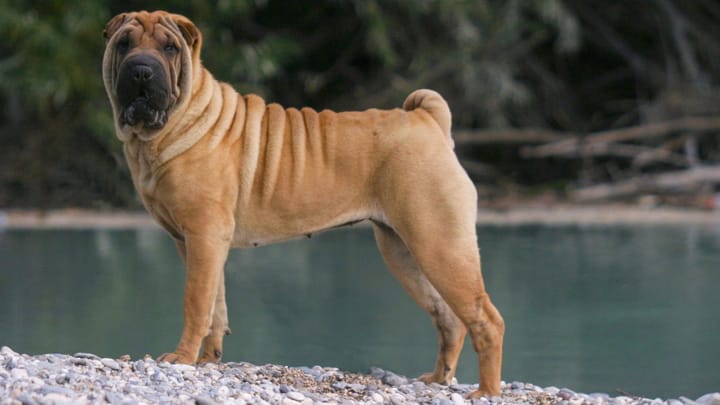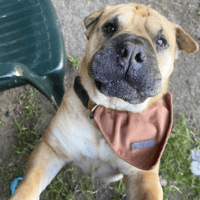Shar Pei
Other names : Chinese fighting dog, Sharpei


The Sharpei dog is an atypical animal, thanks to the skin-folds and blue-black tongue so highly regarded by the breed’s enthusiasts. He has a balanced but independent temperament, so the education of this Chinese fighting dog can be complicated if violent methods are used. He is an intelligent dog that quickly understands what is expected of him if his human colleagues are patient and coherent with him. Protective, calm and affectionate without being clingy, this dog adapts perfectly to family life.
|
Life expectancy |
The Shar Pei has a life expectancy of between 10 and 13 years |
|
Temperament |
|
|
Size |
Medium
|
|
Adult size |
Female
Between 17 and 20 in
Male
Between 17 and 20 in
|
|
Adult weight |
Female
Between 40 and 55 lb
Male
Between 40 and 55 lb
|
|
Coat colour
Only pure colours are allowed except white: black, brown, blue, beige, fawn or cream. The dog's tail is often clearer and darker tones along the back and ears are allowed. The blue Sharpei is particularly appreciated. |
Black Brown Sand |
|
Type of coat
His hair is short. Note that there are two types: The Sharpei horse coat which has very short hair and the Sharpei brush coat which has longer hair, which all the same never exceeds 2.5 cm in length. There is also the Sharpei bear coat which has longer hair (greater than 2.5 cm) but which is generally not recognized by official dog clubs. The hair must be straight, hard and bristling. There is no undercoat. |
Short Hard |
|
Eye colour
Black or brown in beige dogs. |
Brown
|
|
Purchase price |
The Shar Pei costs between £600 and £770 |
It is advisable to always favour the adoption of a dog registered in the Kennel Club. Indeed, like all Molossians, the Sharpei is a controversial figure, especially in relation to his eventual categorization into the standards of the breed. It is always better to be able to justify his origins.
More details about the Shar Pei
Shar Pei: Origins and history
He is a very old breed, but there is no precise information about his origins since they reach back to the Han dynasty - i.e. from 206 years BC to 220 AD. The Shar Pei was particularly widespread in the provinces around the China Sea where it was used as a fighting dog but also as a hunting and guard dog. Today it is a very fashionable dog, highly in demand as a pet and widespread in the United States and Britain: the latter has been awarded "co-ownership" of the paternity of the race.
Physical characteristics of the Shar Pei
The Shar Pei is a sturdy, solid and compact dog with very short hair. The head is large compared to his body, the skull is wide and flat, the top of his beak is a little accentuated. Abundant and fine wrinkles cover the forehead and the orbital region, which then extend downward to form folds. The eyes are small and sunken. The ears are very small, in the form of an equilateral triangle, attached very high above the eyes. The skin forms creases throughout the body, which is a peculiar characteristic of the breed. The tail is located very high, curved above the back but without touching it. Another peculiarity, like his cousin the Chow-Chow, is the Shar Pei’s blue tongue.
Shar Pei: Characteristics
Shar Pei: Behaviour
Training a Shar Pei
This wrinkled dog has the bad reputation of being stubborn, however, he is not. Of course, his upbringing demands consistency and firmness, but it won’t be hindered by a stubborn temperament.
It is true that the Shar Pei has a strong personality, in the sense that if he is rushed or does not understand what is asked of him, he will quit easily. He can be difficult to motivate sometimes. But if he understands what is expected of him and the exercises are repeated regularly, with patience and consistency, he will study with enthusiasm.
Education must be initiated from at the age of 2 months and it should be mixed with high quality socialization.
Positive methods of education are preferred because this combative dog does not appreciate injustice. Although sometimes difficult to motivate, brutal methods will only stunt his progress.
Shar Pei: Lifestyle
Breed compatibility Shar Pei
Shar Pei: Purchase price
The price of a Sharpei varies depending on his origins, age and gender. An average of £770 is asked for a dog registered with Kennel Club.
An average of £40 /month will be required to meet the physiological needs of this Chinese fighting dog.
Shar Pei: Shedding
Light
The annual moults are light and simply, but he requires a brushing regularly.
Shar Pei: Grooming
The maintenance of this dog's short hair is not complicated but requires a certain rigour and constant monitoring, especially with regard to his folds and the skin problems that they engender.
Watch out: some believe that it is necessary to put talcum powder between the folds of the Sharpei’s skin, but it is absolutely not necessary to do this. Simple regular brushings and baths with PH-neutral shampoo are enough to maintain the coat.
Shar Pei: Health
The lifespan is estimated about 12 years.
Although he has a robust constitution, the Shar Pei still has some predisposition to health problems, mainly because of his skin folds.
Like many dogs, the heat is hardly supported by the Shar Pei. Access to fresh water and the possibility to rest in the shade are essential during hot weather.
Since he has no undercoat, this dog does not tolerate the cold and therefore cannot stay out too long. It is not unusual to see dogs dressed with a coat for winter walks.
If his diet is unbalanced, and too few walks are offered to him, this wrinkled dog may actually have a tendency to gain weight.
- Entropy/ectropion (ocular affection)
- Congenital idiopathic megaoesophagus (digestive system condition)
- The Shar-Pei family fever (onset of fevers of unexplained origin)
- Coxo-femoral dysplasia and elbow
- Skin problems due to the numerous folds of the dress (Pyoderma, mucinosis, Demodicosis, atopic dermatitis canine, etc.)
- Localized mastocytoma (skin tumour)
- Allergies
- Difficulties during birth







